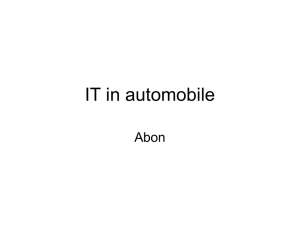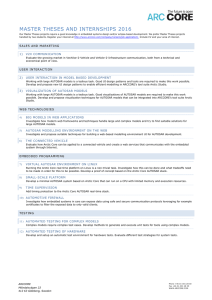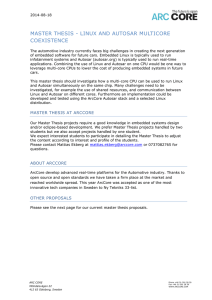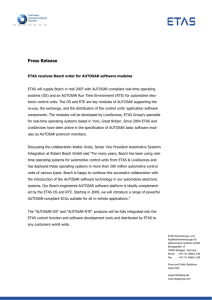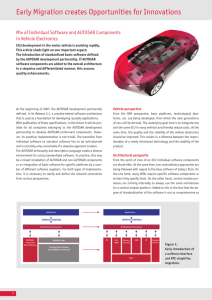AUTOSAR Integration SOA ElektronikAutomotive PressArticle 201911 EN
advertisement
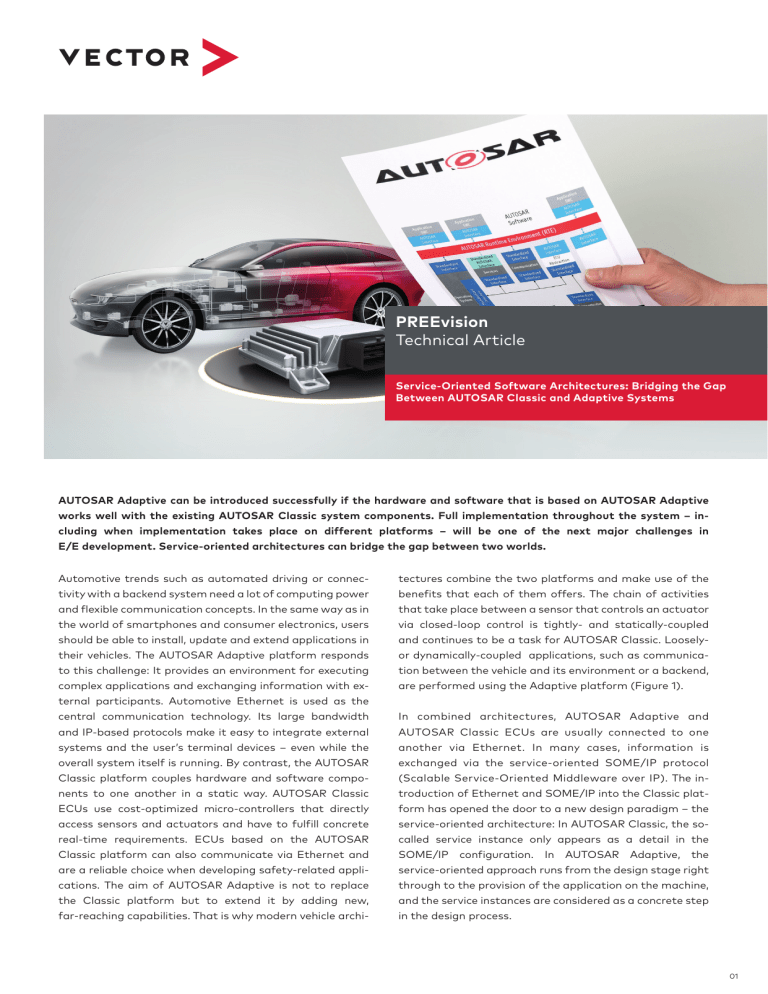
PREEvision Technical Article Service-Oriented Software Architectures: Bridging the Gap Between AUTOSAR Classic and Adaptive Systems AUTOSAR Adaptive can be introduced successfully if the hardware and software that is based on AUTOSAR Adaptive works well with the existing AUTOSAR Classic system components. Full implementation throughout the system – including when implementation takes place on different platforms – will be one of the next major challenges in E/E development. Service-oriented architectures can bridge the gap between two worlds. Automotive trends such as automated driving or connec- tectures combine the two platforms and make use of the tivity with a backend system need a lot of computing ­power benefits that each of them offers. The chain of activities and flexible communication concepts. In the same way as in that take place between a sensor that controls an actuator the world of smartphones and consumer electronics, users via closed-loop control is tightly- and statically-coupled should be able to install, update and extend applications in and continues to be a task for AUTOSAR Classic. Loosely- their vehicles. The AUTOSAR Adaptive platform responds or dynamically-coupled ­applications, such as communica- to this challenge: It provides an environment for executing tion between the vehicle and its environment or a backend, complex applications and exchanging information with ex- are performed using the Adaptive platform (Figure 1). ternal participants. Automotive Ethernet is used as the central communication technology. Its large bandwidth In combined architectures, AUTOSAR Adaptive and and IP-based protocols make it easy to integrate external ­AUTOSAR Classic ECUs are usually connected to one systems and the user’s terminal devices – even while the another via Ethernet. In many cases, information is ­ overall system itself is running. By contrast, the AUTOSAR exchanged via the service-oriented SOME/IP protocol ­ Classic platform couples hardware and software compo- (Scalable Service-Oriented Middleware over IP). The in- nents to one another in a static way. AUTOSAR Classic troduction of Ethernet and SOME/IP into the Classic plat- ECUs use cost-optimized micro-controllers that directly form has opened the door to a new design paradigm – the access sensors and actuators and have to ­fulfill concrete ­service-oriented architecture: In AUTOSAR Classic, the so- real-time requirements. ECUs based on the AUTOSAR called service instance only appears as a detail in the Classic platform can also communicate via Ethernet and SOME/IP are a reliable choice when developing safety-related appli- ­service-oriented approach runs from the design stage right cations. The aim of ­AUTOSAR Adaptive is not to replace through to the provision of the application on the machine, the Classic platform but to extend it by adding new, and the service instances are considered as a concrete step far-reaching capabilities. That is why modern vehicle archi- in the design process. configuration. In AUTOSAR Adaptive, the 01 AUTOSAR – Service-Oriented Software Architectures / November 2019 Figure 1: System architecture that combines AUTOSAR Classic and AUTOSAR Adaptive. The Service-Oriented Architecture from a consumer as a separate, independent transaction. What exactly is a service-oriented architecture? It is a tem- A service that does not contain or store any state informa- plate software architecture in which participants provide tion is referred to as a stateless service. Such services are or consume functions (services) using a defined protocol. highly available and easily scalable. And stateless services The aim is to distribute the logic over a number of atomic also have another advantage: Their function is easy to un- services. They interact with one another to provide more derstand based on the interface description; no knowledge complex functions: Small units with clearly defined func- of their internal behavior is necessary for this. tionalities can be combined easily and be re-used for different purposes. Communication between the services takes A Conceptual Example place over a familiar interface that is defined at an ab- The following diagram shows the service architecture for a stract level. The abstract definition focuses on the func- simple weather service (Figure 2). It was modeled using tionality; the technology that will later be used to imple- concepts from the Service Oriented Architecture Modeling ment the communication plays no role. This is a central Language (SoaML) with Vector’s PREEvision development feature of service-oriented architectures: During the draft environment. The main service LocalWeather delivers con- design stage, the required technologies, necessary resourc- solidated information about the weather for a certain city. es and concrete implementation are initially irrelevant. The service has a provider and a consumer role. The two roles represent service instances in a future implementa- The most important components of a service-oriented tion. The provider and consumer sides of this service architecture are the services: self-contained functionalities communicate via the interface LocalWeatherInterface. The that can be accessed by other services and can be updated relationship between the provider and consumer is repre- and modified separately. Services capture, produce or pro- sented in terms of a usage relation (uses) and is referred to cess data. When acting as a provider, a service makes its as the service choreography. The consumer requests the capabilities available to consumers. As a consumer, a ser- weather for given geographical coordinates which are de- vice uses the data or capabilities of other services in order termined by a GPS receiver. The main service bundles the to provide its own functionalities. A high-value service con- information and makes it available to consumers. sists of multiple simple or atomic services. Services have another important characteristic: They treat every request 02 AUTOSAR – Service-Oriented Software Architectures / November 2019 Figure 2: Service architecture for a weather service modeled using SoaML concepts with PREEvision. To do this, it needs data from other services: The map Implementation in AUTOSAR Systems ­service Map supplies a city code on the basis of the geo- In the AUTOSAR context, a defined service interface can be graphical coordinates. This makes it possible to query the provided or consumed in a Classic or an Adaptive ECU. temperature and humidity in the relevant city from the SOME/IP in combination with Service Discovery is cur- weather service Weather. The interaction between the rently the most common transport protocol for service- ­services is depicted in the form of a dependency relation. oriented communication in both AUTOSAR Adaptive and The interaction between services in a service architecture ­AUTOSAR Classic. However, there is a great difference in that is designed to implement more complex services is the way service interfaces are implemented in the two known as service orchestration. In the concrete implemen- platforms! For example, software components for Adap- tation (Figure 3), the participants are already connected tive are programmed on an object-oriented basis in C++. and have a contract with one another. The participants are abstract elements which, in the Automotive context, could By contrast, Classic components are programmed in C. The be interpreted as ECUs or computers. In any case, all com- runtime environments therefore also differ accordingly and munication is via the service interface. this has to be taken into account when creating and configuring the code. The overall vehicle architecture usually The Service Interface ­determines whether a software component is implement- Services communicate via the so-called service interface, ed as a Classic or as an Adaptive application. The individual which is defined by AUTOSAR on the basis of methods, functions are distributed across different ECUs and com- events and fields (also referred to as attributes or proper- puters in the vehicle network. A service interface can be ties). Methods are operations that can be called by other ­directly assigned to the port of an Adaptive software com- services – usually with parameters. The consumer expects ponent (Figure 4). to receive a result which it can then further process in its own context. Alternatively, consumers can also call fireand-forget methods: In this case, an operation is started at the provider but no result is returned. Events are triggered in the provider’s context. Consumers register for events and are notified when the event has taken place. A provider variable is stored in a field and can be read or written by consumers. In addition, a field triggers an event if the value of the variable has changed. In this way, the provider informs registered consumers of the change. 03 AUTOSAR – Service-Oriented Software Architectures / November 2019 Figure 3: Service orchestration of the weather service with connected service participants. Figure 4: How service interfaces are implemented in AUTOSAR Classic and Adaptive (technology mapping). 04 AUTOSAR – Service-Oriented Software Architectures / November 2019 If the service interface is to be implemented for the Classic Conclusion platform, it must first be translated into interfaces that Service-oriented architectures describe the dependencies are known in AUTOSAR Classic. In this case, a single service and interactions between services. The service interface interface is mapped as multiple sender-receiver, client- contains an exact definition of how these services commu- server and trigger interfaces. Because the mapping is nicate with one another and the data they exchange – in ­defined by the AUTOSAR Standard, this task can be per- abstract form. This makes it possible to understand the formed by an algorithm. This simplification is available to overall system at an early stage, without having to go users of PREEvision, for example. deeply into the technical details. The abstract design makes it possible to validate the system in accordance with When the software ­architecture for the overall system has ­specific rules and is a good basis for the derivation of a been created in this way, all the further steps are plat- detailed AUTOSAR configuration. This approach can be ­ form-specific: derivation of the service interfaces, configu- used for both implementations using both the AUTOSAR ration of the SOME/IP and ­Service-Discovery parameters, Classic and Adaptive platforms. In this way, service-orient- VLAN configuration, setting of the other properties for the ed architectures are able to bridge the gap ­between the implementation of ­ communications, and, for AUTOSAR two worlds and open the way for vehicle architectures that Classic in particular, the configuration of signals, PDUs, the benefit from the advantages of both platforms. socket adapter and the switches. During this task the modern approach of PREEvision is a great help to users because Author it encapsulate complex, ­repetitive tasks. Marcelino Varas Vector Informatik GmbH Product Management Engineer PREEvision AUTOSAR Design Originally published in “Elektronik automotive” magazine Issue 11/2019 – November 2019 05
